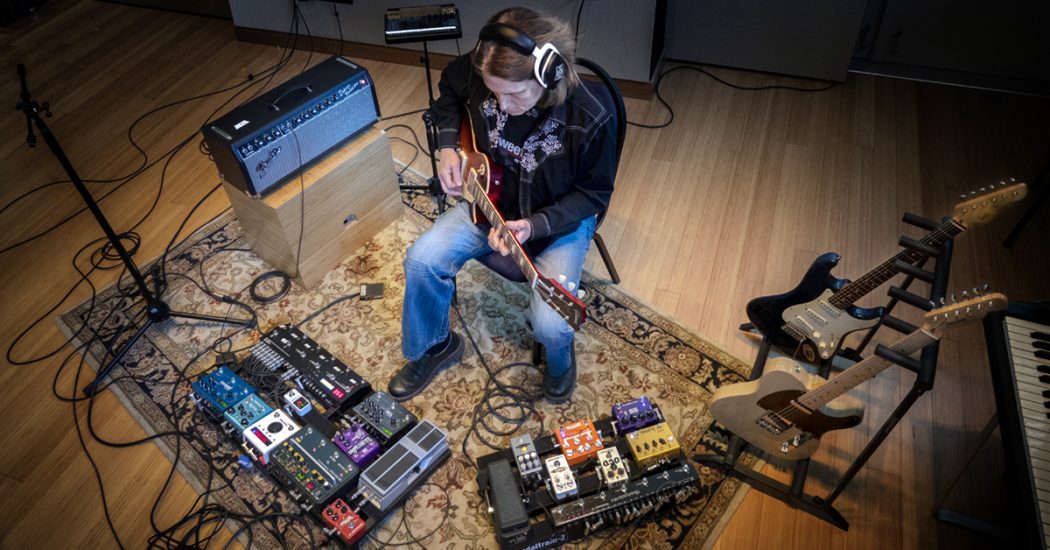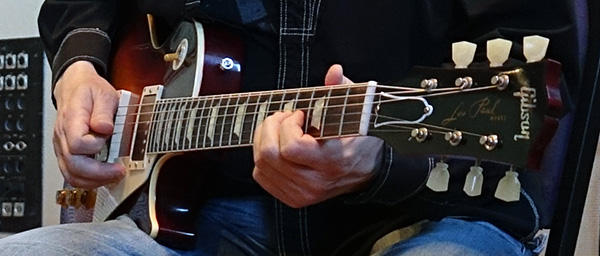
Recording multiple guitar parts on a song is a fun challenge that really helps define the texture, mood, dynamics, and overall feel of the song. Guitar sounds are a wide sonic palette that keeps getting wider, thanks to the current explosion of technology. The technical side of layering guitars has never been easier, more convenient, or less expensive. Here are a few ideas to help you sort through the multitude of options and get the arrangements you want with the least amount of post-production editing and fixing.
Be Intentional
However you decide to arrange your multiple guitar parts — playing together, playing opposite parts, leaving space, filling the track — start out with an idea and work through it. It’s entirely possible that you’ll end up with something different than your original idea, but it becomes your choice and not random happenstance. Of course, happy accidents are always welcome, but don’t leave everything to chance. This will save time in the edit/mix process, because you won’t be searching through a lot of parts and performances, trying to make arrangement decisions and fit pieces together.
Use Different Sounds
 Different sounds sit well in a mix and can either add distinction to different parts or make a single part sound bigger. A snappy clean tone mixed with a fat distorted tone covers a wide sonic spectrum. Those sounds can be playing the same or different parts, panned hard left and right or blended together.
Different sounds sit well in a mix and can either add distinction to different parts or make a single part sound bigger. A snappy clean tone mixed with a fat distorted tone covers a wide sonic spectrum. Those sounds can be playing the same or different parts, panned hard left and right or blended together.
The differences can be extreme or subtle. Try using the same guitar/amp combination, change effects settings and pickup selection, then arrange them playing different parts. For example, start with two parts panned left and right. Try one clean, bridge-pickup part playing raked chords on the downbeats with a long reverb and a shimmery Leslie. Then add another clean sound using the neck pickup, and play eighth-note arpeggios with compression and a quarter-note analog delay.
I recorded a guitar solo that was a “duel” back and forth between two guitars. Both parts used nearly identical signal chains, with two small differences. One part used a wah pedal and a 4 x 12″speaker cabinet with Celestion Greenbacks; the other part was without wah and used a 4 x 12″cabinet with V30s. Everything else was the same. The speakers provided a sonic difference, the wah changed my playing approach, and the duel ensued.
Arrangement Options
Think of two rhythm parts like they are having a conversation. Both parts can be simple, but the exchange is back and forth mostly. Keith Richards and Ronnie Wood of the Stones are the classic example. They play off each other so well from an arrangement standpoint, leaving space, playing into or out of the other player’s part, or weaving parts together to make one cohesive sound. This is an arranging approach that works regardless of style.
Adding or subtracting parts is an effective way to change the song’s dynamics. Bring in a heavy, low rhythm guitar to add weight to a section, take away all the guitars except a chunky riff to drop the bottom out and highlight that particular part, add an octave up or octave down to a riff to give it emphasis and add drama at the very end of the song — the options are nearly infinite.
Stacking Options
A second performance of the same part with the same sound will give you a better result than just copying the same performance onto another track, even if it’s time-shifted. The minor performance inconsistencies will add depth, groove, and a little attitude — that human element.
Mic the strings on an unplugged electric guitar playing the same part to add more attack to a traditional electric rhythm sound.
Double a heavily distorted rhythm part with acoustic guitar to soften it.
Use a miked amp mixed with a modeled or direct sound for different textures. Try using a miked-amp sound as the main guitar part and using modeled sounds to add color on the subsequent parts.
Use a DI so you have the option to re-amp, or use a plug-in guitar model for modifying the tone, but don’t rely on making all those decisions at mix time. Dial up a tone you think is right, and commit to a sound and performance. It will give you a creative starting point to build other parts and sounds from. If you have a DI track and you no longer think the original sound works, you have the option to try others, but you’re not starting from scratch.
Use the same post processing on parts that are doubled or tripled. You can bus all the tracks through the same effects sub-mix to make them even more cohesive. At mix time, all those tracks exist more as one part.
Use panning and mix balance to distinguish parts and sounds. Try slightly panning a doubled part and bringing it down a little in the mix. Take a tripled part and make the main guitar loudest and panned center, turn the other two down 20%, and pan them 40% left and right.
Timing, Attack, Intonation

These fundamentals of guitar recording are made way more obvious when multi-tracking guitars.
Timing
Playing in time and with a groove is the foundation. The next step is the specific rhythmic subdivision and placement of a note on or around a beat. Your ability to recognize and manipulate this in your playing can determine whether or not your tracks sound tight and convey the kind of feel you intend. Whether you play staccato and on the front edge of the beat or legato with a lazy downbeat and a slightly swung 16th-note feel, these considerations are even more important when you’re doubling or tripling a track, because the performance differences are highlighted when they’re side by side. Sometimes the differences have a cool result, but make that intentional instead of random.
Attack
There are so many ways to attack a guitar string: hard, soft, pick, fingers, fingernails, etc., not to mention the variety of pick sizes and materials or the various angles at which you can strike the string. Don’t forget about muting, picking close to the bridge, or close to the fretboard. Again, these techniques can help your tracks sound more or less together, and by paying attention, you can achieve the desired effect.
Intonation
Here are some things you should remember when doing multiple-pass arrangements while recording.
- Tune your guitar before every take and periodically recheck.
- Have all your guitars intonated properly so they are in tune everywhere on the fretboard.
- Make sure you don’t pull strings with your fretting hand or overplay with your picking hand so much that pitches are sharp.
- Fretting-hand vibrato can be a pitch issue, especially if one part has vibrato and another doesn’t.
- Pitch-shifting effects can sit oddly with other tracks, so listen carefully to the finished track in context with everything else.
The best advice overall is to use your ears and listen to the finished product. Details matter. If it sounds good and it sounds the way you intended, it’s a success!



